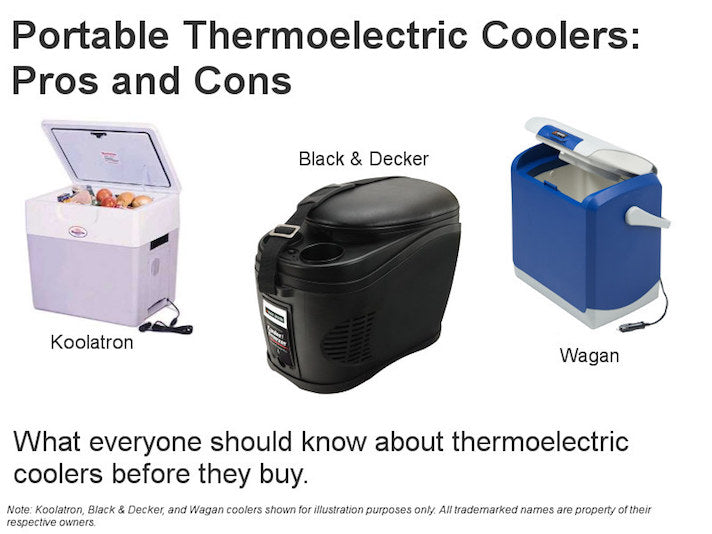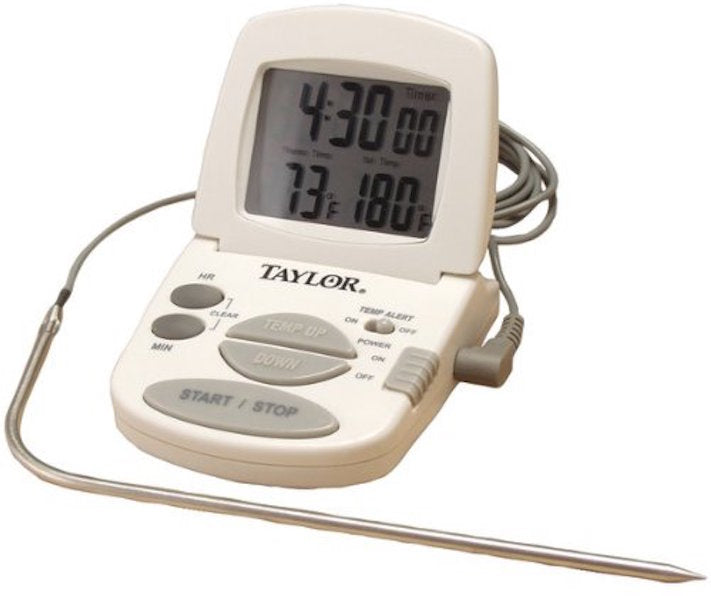Thermoelectric coolers are pretty cool (pun intended). They've got the insulating qualities of a standard ice-chest cooler, but unlike simple ice chests, they use a solid state device (powered by electricity) to keep things cool.

Like any other device, there are pros and cons to thermoelectric coolers. Since many of the people who buy an ArkPak or Powerpack battery box often purchase some sort of electric cooler or portable refrigerator, we decided to go over those pros and cons of thermoelectric coolers here on our blog.
First, Here's How Thermoelectric Coolers Work
Inside every portable thermoelectric cooler there's something called a Peltier plate, and it's the Peltier plate that makes the cooler cool. It's called a "Peltier" plate because it uses a scientific principle discovered by French physicist Jean Charles Athanase Peltier in the 1840's. Peltier found that you could create heat (or cooling) when you forced electric current thru two dissimilar conductors. Practically speaking, this means you can build a semiconductor, sandwich it between two different metals, and then plug it into a power source and you've got a cooling (or heating) device.
 These are some very small peltier plates used to help keep computer processors cool. Image is courtesy ActiveCool.com, which has a very good explanation of the science behind thermoelectric cooling here.
These are some very small peltier plates used to help keep computer processors cool. Image is courtesy ActiveCool.com, which has a very good explanation of the science behind thermoelectric cooling here.
The peltier plate in a standard portable thermoelectric cooler consumes 3-5 amps. It is capable of temperatures that are about 40 degrees Fahrenheit lower than ambient temperature. This means, for example, that if your cooler is sitting outside on an 80 degree day, the coldest it can get is 40 degrees. Unlike refrigerators, thermoelectric coolers are only capable of differential cooling -- the hotter it is outside the warmer your cooler will be inside.
Portable Thermoelectric Cooler Pros and Cons
PRO: Thermoelectric coolers are far less expensive than portable refrigerators. A portable refrigerator designed for use while camping or boating can cost $600+. A thermoelectric cooler can be had for $100-$150, depending on size.
CON: Thermoelectric coolers aren't usually temperature controlled. Portable refrigerators are designed to maintain a specific temperature, which is what most people expect when they buy a thermoelectric cooler. However, most people either find that their thermoelectric cooler is too cold (freezing the contents) or too warm (drinks and food aren't cold enough).
This is because thermoelectric coolers are differential coolers - they can only make the inside of your cooler about 40 degrees colder than the outside air. For example:
- If it's 90 degrees outside, your thermoelectric cooler will be about 50 degrees inside (90-40 = 50)
- If it's 60 degrees outside, your thermoelectric cooler will be about 20 degrees inside (60-40 = 20)
A portable refrigerator works on a completely different principle, so it doesn't have this problem. Portable fridges stay the same temperature no matter what (assuming they're plugged in of course).
PRO: Thermoelectric coolers are rugged and reliable. Because they have few moving parts, thermoelectric coolers can be dropped or kicked without risk of damage. The only part of a thermoelectric cooler that can wear out is the fan that circulates outside air across the plate. As long as that fan is functional, the cooler should work just fine.
CON: Thermoelectric coolers aren't very energy efficient. Most thermoelectric coolers need 3 to 5 amps of current at 12V to stay cold. That's 3-5 times the amount of current a good quality portable fridge needs.
PRO: Thermoelectric coolers last a long time. At some point, the peltier plate in a thermoelectric cooler will wear out, but it shouldn't be for a very long time (years of use is probable). In fact, many truck drivers buy and use one single thermoelectric cooler daily for years at a time. They'll work just fine for occasional use camping, boating, etc.
CON: Thermoelectric coolers might not be safe for storing food. According to FoodSafety.gov, foods like milk, meat, butter, cheese, and jam or jelly should be stored at temperatures below 40 degrees Fahrenheit to inhibit bacteria growth. If these foods are warmer than 40 degrees, they can become breeding grounds for bacteria that can lead to food poisoning.
If your thermoelectric cooler is being used where the ambient temperature is above 80 degrees, than foods stored inside the cooler may not be safe (only, having said this, food can be stored at temperatures above 40 degrees for an hour or two without ill effect - see this guide for more info).
 A simple digital cooking thermometer with a remote probe can help you monitor the temperature inside your cooler.
A simple digital cooking thermometer with a remote probe can help you monitor the temperature inside your cooler.
TIP: If you get a thermoelectric cooler, consider buying a digital cooking thermometer with a remote probe. You can place the probe inside the cooler, then periodically check the temperature to make sure your food isn't getting too hot or too cold.
PRO: Thermoelectric coolers are generally heavily insulated. Portable thermoelectric coolers are just like regular coolers in terms of insulation. Cold food inside the cooler should stay cold for a few hours, even without power (just don't open the cooler as you'll let all the heat in.
CON: Thermoelectric coolers can't get wet (inside or out). Regular coolers - as well as most portable refrigerators - work just fine if they get wet inside. You don't have to worry about ice melting and ruining either. But if you put some ice inside your thermoelectric cooler, and that ice melts, it can damage the peltier plate in your cooler and ruin it.
PRO: Thermoelectric coolers can be run in reverse (heating food instead of cooling it). If you're looking for a device that can heat your food - say because you're transporting some dishes to a pot luck or something - a thermoelectric cooler can warm food to ~140 degrees. That's not hot enough to store food long term, but it's hot enough to keep dishes warm.
Should You Buy A Thermoelectric Cooler?
Obviously, portable fridges are better than thermoelectric coolers for keeping food (and drinks) cold. If money is no object, just go with a portable fridge and be done with it.
But if you're trying to find an alternative to a traditional ice chest cooler that will keep food cold without having to deal with ice (and without breaking the bank), a thermoelectric cooler could be a good option. Just make sure that:
- You understand the limitations of thermoelectric coolers in terms of temperature control and plan accordingly. If you're expecting it to function just like a refrigerator, you're going to be disappointed.
- You have plenty of power available to run the cooler. If you try to run a 50W thermoelectric cooler off a standard vehicle battery (without your vehicle engine running), you've just got 3 or 4 hours before you risk killing your battery. You can plug the cooler into an ArkPak or Powerstation battery box for much longer (12-24 hours, depending on the size of battery inside your ArkPak, the size of the cooler, etc.), but even then you've only got a day (or so) worth of power before you need to recharge your ArkPak or battery box.
Summing up, thermoelectric coolers are great for day trips, tailgating, boating, or even overnight camping trips provided you've got something like the ArkPak to provide power. However, if you're looking for a cooler that will keep food cold for a week in the wilderness, for off-the-grid living, etc., a portable fridge is probably a better option.
Still, if you're looking for a cooler that will keep your food and drinks cold during a road trip (where the cooler can run off your vehicle's engine power), or if you only need the cooler for a day or so at a time (and you have a powerful portable power pack to go with it), a thermoelectric cooler isn't a bad option. Just keep it out of the sun to maximize efficiency and keep a close eye on temps inside the cooler.
